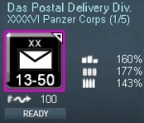wpurdom
Posts: 476
Joined: 10/27/2000
From: Decatur, GA, USA
Status: offline

|
quote:
quote:
4. Do not let the Finns attack south of the no attack line. This would still let the finns move south if the Germans clear the way for them, which I think is generous when considering the historical situation. Historically, I think it would have been extremely doubtful if one single finn would have stepped over that line even if the Germans had captured Leningrad three times over and made it into a parking lot.
I was exchanging email with a Finn some years back who felt that their only goal in the Continuation War was to regain what they lost in the Winter War, and nothing more. He felt that they wouldn't have moved one inch further than they did, no matter how well the Germans did. This is reinforced by the general disgust the Finns felt for what the Nazis were doing in the captured territories.
Of course, if there was a chance to gain territory and wealth, perhaps the Finns might have been lured out anyway. Hard to say. The Germans likely would have had to do MUCH better than they did historically before they would risk angering the Soviet Union (because they didn't take anything more, or doing anything nasty, the Soviets were willing to let the Finns quietly exit the war - unlike the Germans who they were going to kick until it wasn't fun any more, and then do it a while longer anyway).
Most games have the Finnish front as an "its there" type thing, but little more - you have to keep enough forces there to keep the Finns in check, but that is it. Although most games also feel that if the Germans captured Leningrad, the Finns would have moved further out.
Armies don't generally march on something just because its there. There is a reason to take it. It may be strategic (a cross road, a fortification, a good location to secure the flank from), it may be industrial (the real goal of war is not to shoot the other guy's troops, it is to destroy his ability to make war against you, his troops want to do that to you, and stop you from doing it to him), it may be resources (that was why the Japanese invaded in the Pacific, and the Germans looted as many resources as they could - inefficiently, but they did it), it could be wealth (the Germans looted billions from the conquered territories to help pay for the war), or it could simply be on the way to one of the above, but there is a reason.
That's the Finnish story and they're sticking to it, but it turns out not to be the case - though I'm sure it's what your friend was taught by his parents and school. Look at Finland's War of Choice by Henrik Lunde.
Maintaining this story was very important to Finnish independence during the Cold War.
North of Lake Lagoda, the Finns advanced to the 1939 border with light losses, destroying 2 Soviet divisions - the 54th and 27th as well as a NKVD regiment. Then in September, while the Germans were approaching Leningrad, they engaged in fierce battles involving heavy casualties to penetrate the 1939 line north of Lake Lagoda to take Petrozavodsk and the Murmansk-Volkov line, destroying the Soviet 3d division and another divisional equivalent (marine brigade and 2 regiments). Thereafter in November and December they drove northwest to the northern end of Lake Onega and the town of Medvezhyegorsk taking and inflicting further heavy losses. The also drove across the Svir taking bridgeheads, including one 100 kilometers by 20 km.
In this early 1941 phase of the war the Finns suffered 25,000 killed out of total casualties of 75,000, a few more than in the Winter War and half of their losses in the Continuation. In the Continuation War, the Finns estimate that the Soviets lost 270,000 killed and 550,000 wounded.
The Finns had their own divisions about the Continuation War, the Social Democrats mostly felt they should stop at the 1939 borders, while there were substantial portions of the military and political leadership which saw the attractions of a "Greater Finland" to include Soviet Karelia (which though ethnically related had never been part of the Duchy of Finland) and to achieve lasting security by the breakup of their historic adversary. President Ryti stated in a note to the Germans that he wanted the entire Kola Penisula for Finland though later he had second thoughts if it involved a common border with a Russian or Soviet state. Mannerheim's General orders early in the war, one broadcast over Finnish radio called for the liberation of Karelia and freedom for a greater Finland that included Karelia.
It does seem that Mannerheim made a conscious decision not to help bring about a conquest of Leningrad - that front went quiet at the beginning of September and the Soviets were able to transfer 2 of their 6 divisions to the German front. In terms of further offensives northeast of Lagoda, however, the Finnish offensive went on as we have seen and stopped as much due to logistics and manpower issues as anything - the Finns initially put 16% of their population into the army and like the Brits in late 1944 were overcommitted in manpower - they needed to and planned on reducing the size of their army, and demobilized a divsion for replacements. And when pressed for offensive action by the Germans, Mannerheim promised to renew the offensive on the Svir line as soon as Leningrad fell - hence the rule in WITE.
Actually, on the Finnish front, the WITE rule is too kind to the Soviets. To somewhat mimic their situation, the 23rd army should have its own no-move line to not pass the Narva or Volkov in 1941 and the 7th should freeze after it crosses the no attack line until the end of the year. Even that doesn't duplicate the reasoning that led the Soviets to sacrifice numerous forces north of the no attack line.
I don't want to sound too harsh to the Finns. They were caught between the sword and the wall. They explicitly sought Soviet approval of annexation by Sweeden with the 1940 boundaries and a commitment to neutrality and the Swedes were willing, provided the Finns promised no new war with Stalin, but Stalin blocked it by threatenting attack. A big mistake by Stalin as it turned out. They also needed someone to allow importation of grain - which had to be the Germans or the Soviets, and the Soviets weren't interested in an accomodation with the Finns before July 1941. But they didn't fight a defensive war or confine themselves to the 1939 border either - which the UK and US told them was what they needed for continued support diplomatically vis-a-vis the Russians.
Finally, in terms of quietly exiting the war, initially Stalin was willing to return to the 1939 boundaries, an for some concessions if they simply stopped at the 1939 lines but didn't exit the war. After their late 1941 offensive, that went out, but right up until the end of 1943 Stalin was prepared to let them out on the final peace terms, essentially, maybe a little better. Then as he prepared the 1944 offensive, those terms came off the table. The Finns somehow were caught totally unprepared for the 1944 offensive and lost heavily in the early stages and Stalin seemed to reconsider annexing Finland. But then the resistance stiffened and the Soviets got bogged down, taking heavy casualties, so Stalin decided he didn't want to delay rolling into East Europe trying to finish the Finns, so he went back essentially to his pre-offensive peace terms. If the Finns were that hesitant to tee off the Soviets they wouldn't have gone past the 1939 borders at very heavy cost to both them and the Soviets.
< Message edited by wpurdom -- 8/16/2011 12:50:23 AM >
|
 Printable Version
Printable Version



















 but in reality Axis had at last used some artillery to siege the city and to destroy some areas making rumbles. I would then agree that theses rumbles could at least increase defensive abilities like a counterpart of the actual rule if axis would like to attack after this (rumbles of stalingrad are often described like a cimetery for axe and leading a rats war).
but in reality Axis had at last used some artillery to siege the city and to destroy some areas making rumbles. I would then agree that theses rumbles could at least increase defensive abilities like a counterpart of the actual rule if axis would like to attack after this (rumbles of stalingrad are often described like a cimetery for axe and leading a rats war).  New Messages
New Messages No New Messages
No New Messages Hot Topic w/ New Messages
Hot Topic w/ New Messages Hot Topic w/o New Messages
Hot Topic w/o New Messages Locked w/ New Messages
Locked w/ New Messages Locked w/o New Messages
Locked w/o New Messages Post New Thread
Post New Thread